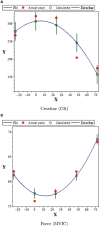Kinetics of Muscle Damage Biomarkers at Moments Subsequent to a Fight in Brazilian Jiu-Jitsu Practice by Disabled Athletes
- PMID: 31507436
- PMCID: PMC6716534
- DOI: 10.3389/fphys.2019.01055
Kinetics of Muscle Damage Biomarkers at Moments Subsequent to a Fight in Brazilian Jiu-Jitsu Practice by Disabled Athletes
Abstract
Purpose: Evidence indicates that muscle injury caused by exercise can lead to functional, biochemical, and clinical damage. These outcomes encompass an intrinsic potential to understand the real magnitude of interpretation of classic signs in sport environments and to monitor athletes, contributing to specific actions. However, little or no research has explored the general behavior of the variables presented in response to paradesportivo Brazilian jiu-jitsu. The objective of this study was to investigate the physiological behavior through clinical, functional, and metabolic outcomes in the moments following a simulated fight. Methods: Six disabled athletes, male Brazilian jiu-jitsu practitioners (34-44 years old), were included. The participants had their outcomes analyzed individually and the variables studied were correlated. It is noteworthy that participants I and II are professional athletes with world titles. The ethics committee involving human beings of the Federal University of Mato Grosso (register no. 2.997.241) accepted the study. The participants attended the collection site four times, with a 24-h interval between sessions, characterizing the following moments: pre-exertion, and post-exertion, 24, 48, and 72 h after the simulated fight. Data collected were muscle pain, perception of recovery, muscle strength, and blood samples for creatine kinase (CK) and lactate dehydrogenase (LDH) analysis. The variables described were measured at all collection moments. The data were presented in individual raw values of each participant, with Spearman correlation analysis to verify the relationship between variables and moments. Results: The outcomes demonstrated that the CK and LDH activity was higher of high-performance parathletes (I and II) and the reported muscle pain was lower. The fight did not influence maximal isometric strength levels in either participant. In addition, regarding delayed effects, the participants reported peak pain, CK, LDH, and decreased perception of recovery within 24 h. However, it was found that, at 72 h, all values had recovered, close to baseline levels. Conclusion: The presented outcomes provide parameters and suggest a safe scenario based on the intensity and volume commonly adopted in this sports parade modality where the level of effort recommended during combat does not seem to cause deleterious damage.
Keywords: creatine kinase; inflammation; martial arts; musculoskeletal physiological phenomena; physical therapy specialty; sports medicine.
Figures





References
-
- Adams J., Kirkby R. (2001). Exercise dependence and overtraining: the physiological and psychological consequences of excessive exercise. Sports Med. Train. Rehab. 10, 199–222. 10.1080/10578310210395 - DOI
-
- Andrea C., Betts M. P. H., Grobe K. F., Simon D., Carlton M. P. H., Kramer K. (2018). Reducing barriers to healthy weight: planned and responsive adaptations to a lifestyle intervention to serve people with impaired mobility. Disabil. Health. 11, 315–323. 10.1016/j.dhjo.2017.10.008, PMID: - DOI - PMC - PubMed
-
- Andreato L. V., Julio U. F., Valeria L. G., Panissa J. V. D. C., Hardt F. E., Moraes S. M. F., et al. . (2015). Brazilian jiu-jitsu simulated competition part I metabolic, hormonal, cellular damage and heart rate responses. J. Strength Cond. Res. 29, 2538–2549. 10.1519/JSC.0000000000000918, PMID: - DOI - PubMed
LinkOut - more resources
Full Text Sources
Research Materials

